In Galicia, four sisters are taking on the male-dominated culture of percebeiras.
Xosé Lorenzo is in the middle of explaining how he got the seven stitches on his scalp and the eight on his leg when a call rings out from the other side of the rocks. A pack of men and women in wet suits aim a chorus of shouts and whistles and waving arms at the bald, bearded game warden, who squints into the light and cups his right hand to his ear. Waves crash wildly against the coastline, a wall of white noise that muffles the panic bubbling over in the distance. Finally, a single voice rises up above the churn of the Atlantic: A man is down and he’s being swept out to sea.
Xosé holsters his binoculars and takes off at full speed toward the source of the commotion. He moves quickly, but the arms wave ever more wildly, and between him and the emergency, an obstacle course of jagged rocks, slippery stones, pools of seawater. Everyone, a dozen people at least, has dropped their gear and are making their way down the coast as quickly as possible, which isn’t nearly quick enough.
Suddenly, on the inside track, bounding from one rocky precipice to the next like a pair of mountain goats, two women in wet suits break away from the pack: one short, compact, with a bouncing blond ponytail, the other large and solid with a bob of crinkled red hair. Without breaking stride, the larger woman pulls a rope from her pack and ties a loop at the end. Twenty meters (65 feet) beyond, in a rough channel of ocean churn, a portly fisherman in a checkered shirt is clinging to a triangle of quickly vanishing stone. Even from this far away, you can see his arms shaking, struggling to hold on as the force of the ocean sucks him out toward the horizon.
A raging chauvinist saved by a couple of women
The women loop the rope around a rocky appendage and take off swimming toward the man and his diminishing island. Another man joins them, and together, the three lasso the fisherman, wrap him in their arms, and begin to swim him slowly back across the channel.
A dozen hands wait on the other side. An ambulance arrives to take away the man, who will live to fish another day. Spearing for octopus on a rough outcropping of rocks, a rogue wave came in and washed him off his feet. Had he been alone this morning, the taller woman says, picking up her gear and getting back to work, he would be dead.
Then the shorter one flashes a little smile. “He’s famous around here for being a machista,” she says. “Imagine that: A raging chauvinist saved by a couple of women. It will be a long time before he lives this down.”
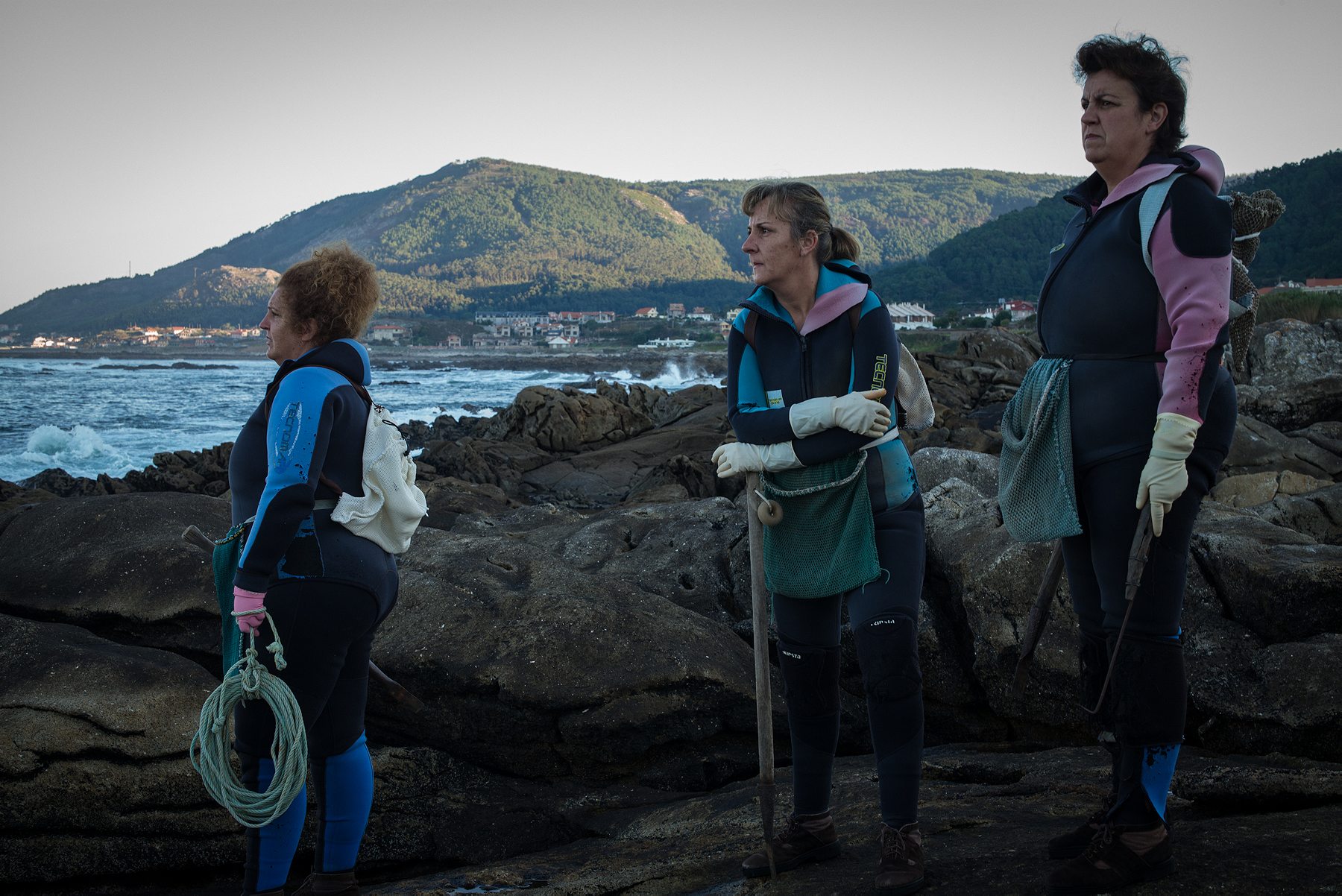
But Susana and Isabel González are not just a couple of women. They are percebeiras, hunters and gatherers of the gooseneck barnacle of the Spanish Atlantic.
Tucked into the northwest corner of the Iberian Peninsula, Galicia has long been shorthand for Spanish seafood supremacy, a distribution center as much as a destination, a fountain from which flows the most sterling examples of rockfish and razor clams, oysters and urchins, monkfish and mussels. Anything from Galicia commands premium prices in Spain and beyond, but the king of the ocean here, at least by the time it lands on the ice beds of wet markets across the country, is the gooseneck barnacle, known in Spanish as the percebe.
Galician barnacles are short and slender, with a hard, rocky base and a dark, leathery sheath hiding a single finger of ocean meat that drives Spaniards wild. Boiled briefly and seasoned with nothing but the essence of the ocean, percebes combine the same wave of umami and undertow of sweetness particular to all great seafood, only in a dense package with a taut, snappy texture. In a country where people are willing to invest an imprudent percentage of their income on ocean treasure—Catalonian red shrimp, Asturian spider crabs, Cantabrian anchovies, percebes can fetch up to 200 euros ($216) per kilo (2.2 pounds), nearly half of which is inedible, making it one of the most expensive delicacies in the world.
The elevated price reflects a confluence of both market and organic factors: the unpredictability of supply, the uncontrollable elements that create quality barnacles, the massive seasonal swings in demand. And, above all, the danger of being a percebeiro. Barnacles grow in very specific places: namely, clinging to the sides of sharp rocks with full exposure to ocean swells. To be a successful percebes hunter, you must negotiate a series of natural challenges—frigid water temperatures, the fierce Galician weather, and the force and unpredictability of the ocean at its angriest. Almost everyone living in these coastal towns has lost a friend or a family member to the Atlantic.
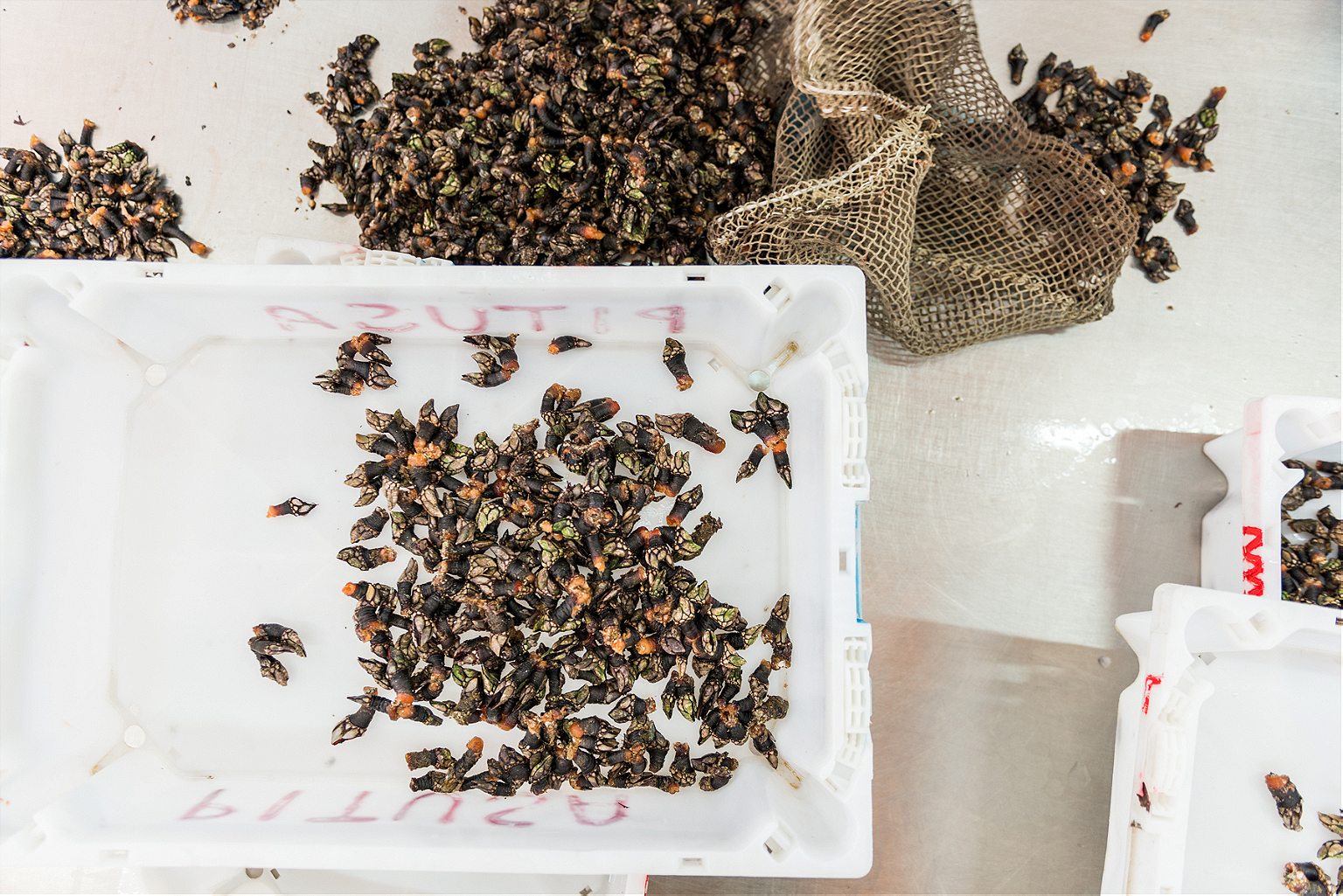
The González sisters have the barnacle business in their blood. Both of their grandmothers were percebeiras, women who scratched out a living from the cracks and crevices of the Atlantic coast. Their maternal grandfather was called on to fight with Franco in the Spanish Civil War, and though he made it home alive, he never fully returned. With eight children and a local economy driven exclusively by farming and fishing, his wife took to the rocks to feed the family. After collecting a cache of percebes, she would travel 30 kilometers (18.6 miles) up the coast to Vigo with baskets of barnacles on her head to sell at the city market.
Her only daughter Palmira, the González sisters’ mother, took up barnacle hunting at a young age. Palmira would ride her bicycle down the coastline with her mother packed on the back in search of a decent living. She spent so much time between the spokes and the stones, riding up and down the coast in search of barnacles, that she lost her first baby to a miscarriage. The doctors implored her to give up percebes hunting the next time she got pregnant.
In 1963 Palmira married Eduardo, one of Bayona’s most famous percebeiros, a man known for his bravery in tough conditions, his intuition, and for a rare skill among the percebes hunters of his day: He knew how to swim. “There was one rock along the coastline that was known to be covered with the best barnacles in the area,” says Isabel. “No one could get to it—nobody except my dad. He was a water buffalo, fearless, immovable. When his friends came back with 10 kilos, he’d come back with 20.” But it wasn’t just his skill that earned him repute: Eduardo was known for his humility, for his unwavering support of his fellow percebeiros, for risking his life in the name of others. “He saved a lot of lives, but he also saw a lot of friends die.”
Eduardo always said he wanted to have a son so that he could raise a respected percebeiro in his image. Instead, he had four daughters. “We were all born at home,” says Isabel. “When the wet nurse came in to announce the last birth, he nearly dropped his coffee. ‘Wow, another one!’ ” Lala, Isabel, Susana, and Belén: The González sisters of Galicia, born with the ocean in their eyes. But the barnacle world wasn’t a preordained destination. Each sister set out on a different career path. Lala owned a food market, then worked as a pastry chef in a local bakery. Isabel sweated out years as a line cook at a small tapas bar in Bayona. Susana was an administrator for a pharmaceutical company.
But the siren call of the sea proved too much to resist, and by the time Belén left her job working retail at a local market, all four of the sisters had gone the way of their grandmothers. They embraced an unspoken pact: to always work the rocks together, to watch over each other in the way that only family members can. Together, they would form a team stronger than the sum of its parts. And in that way, they’d stay safe. “The first thing we’ve always done when leaving the water is call our mom to tell her we’re safe,” says Susana. But turns out their biggest challenge wasn’t the whims of the sea, but the colleagues they worked alongside. The plump octopus fisherman was not the first machista the sisters have wrapped their arms around. Barnacle diving, like the fishing industry the world over, is a male-dominated profession, even if this southern corner of Galicia has a long tradition of women working the rocks.
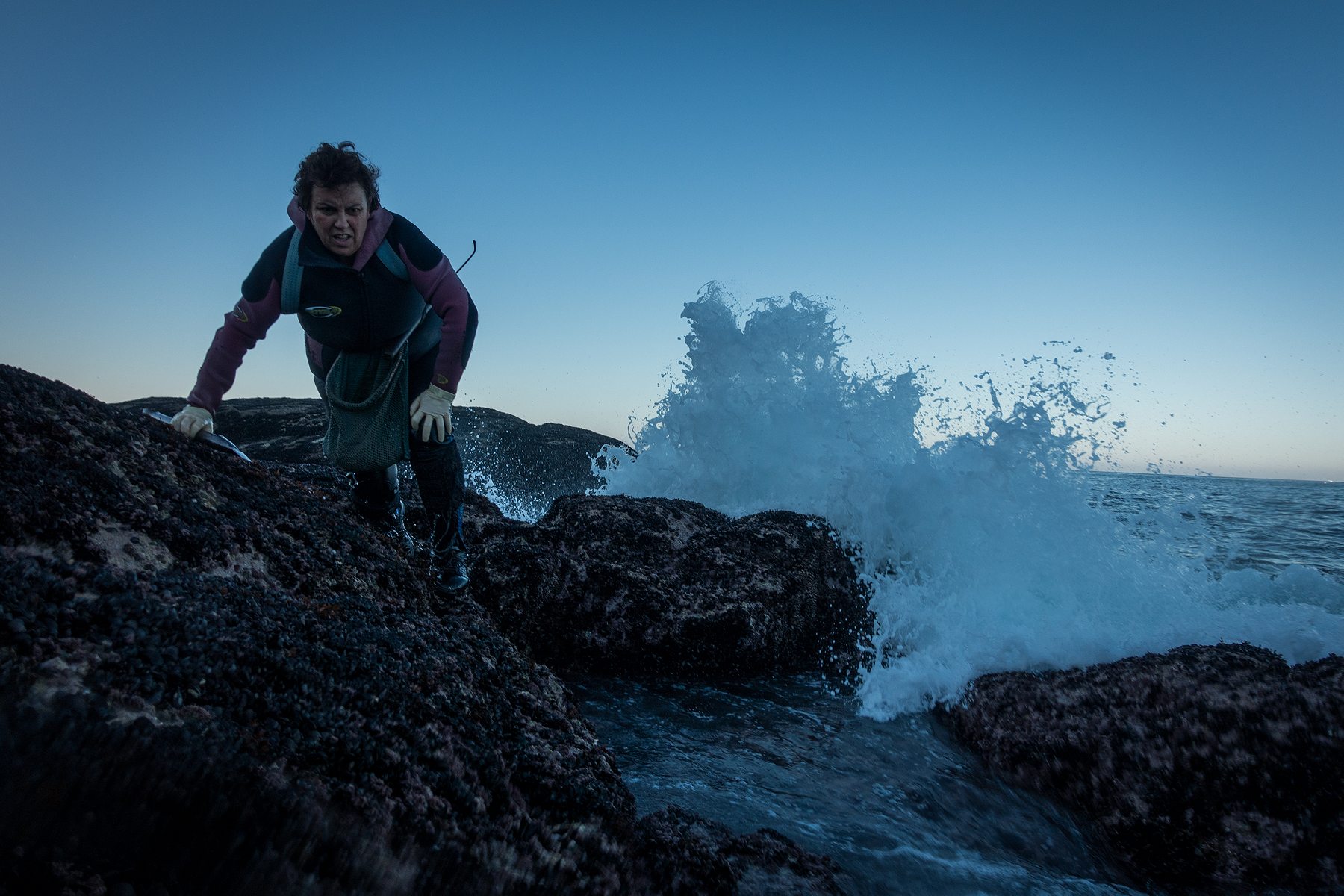
For as long as barnacle sales have been regulated by the government, women and men have been treated differently: For many years, men were allowed a quota of five kilograms of percebes per day, while women were allowed just three. And when it came time to sell the barnacles in the afternoon auction, the two groups were separated, with women only allowed to sell their catch once the men had offloaded theirs.
We’re not talking about the 1920s or the 1950s or even the last few decades of the 20th century. This practice persisted until 2003, when Susana decided to run for president of Bayona’s percebes association. This is no idle role: The president works to implement new rules, enforce quotas, serves as a conduit between the percebeiros and the Galicia government. Needless to say, her candidacy was not well received by the old male guard on the docks of Bayona, many still possessed by the same laws of machismo that prevail in many corners of Spain. Protests formed, threats followed. Even many of the women divers, long accustomed to the established hierarchy, viewed Susana’s ambitions as an unnecessary challenge to the status quo.
As her sisters and parents and pretty much anyone in this town of three thousand inhabitants will tell you, Susana does not back down from a challenge. When she was 11 years old, she canvassed middle school administrators to change the lunch rules so that boys and girls could all eat together. “I don’t have more rights than anyone. But I don’t have less, either.” She’s let that conviction carry her from one cause in life to the next. When she left her job to work the rocks, she fell instantly in love with almost everything about her new profession: the open air, the ever-changing office space, the sisterly camaraderie. But she didn’t love the way she and her fellow women were treated.
“Imagine, most of these guys go home, slam their hands on the table, and watch their wives obey their commands. They wanted us to do the same, but that wasn’t going to happen.”

The campaign was tough on the family, on all of Bayona, really, because Bayona is the kind of small Spanish town where individual pains are felt as communal wounds, but Susana prevailed, winning 65 votes to her opponent’s 55 on the back of a late tide of support from Bayona’s female divers. The tensions stirred up during the elections, though, died hard. “During the first meetings, the national police force had to send out a patrol unit to keep the peace. The men would insult us, threaten us, try to intimidate us.”
The breaking point came when Susana announced that men and women would have equal quotas. “Tables were turned over. Chairs flew. They said that we were stealing their livelihood. That as women, we didn’t need to provide for our families—only they did. We came to the percebes world to bankroll our vices, to buy makeup and creams. Those were a rough three or four years.”
Susana wasn’t done, though. In 2014 she ran a successful campaign to become president of the Cofradía de Bayona, overseeing all fishing—crab, octopus, sea urchin—in the town’s 20-kilometer stretch of coastline.
In an extra blow to the old guard, Susana’s vacated seat as the president of the percebeiros was soon filled by another González—her older sister, Isabel.
Life is slowly slipping away from Galicia’s farthest reaches
Galicia, depending on how you look at it, is either where Spain ends or where it begins. A postage stamp region tucked into the northwest pocket of Spain, the gallegos share a border with Portugal, a bloodline with the Celts, and a twisted coastline that makes for a rough welcome mat for the rest of the world.
Along the fringes of Galicia, clusters of tiny islands block the mouths of the region’s fabled rías, massive estuaries that carve watery arms into the coastline. (On the outskirts, the grandest of Galician islands, the Islas Cíes, play host to the types of baking-powder beaches that countries can build entire economies around.) Inland, along the rolling valleys and steep river slopes around Ourense, you’ll find one of Europe’s most underrated wine regions, where the cool temperatures and heavy rainfall creates white wines—Albariño, Godello—of steely complexity. Deeper still into Galicia, dramatic sierras hide tiny villages that shrink with each passing season. In Cuera, population 47, a child was born in 2014, the first new face this dwindling community has seen in 25 years. The town rejoices, but life is slowly slipping away from Galicia’s farthest reaches.
Galicia’s has long been a surf-and-turf economy, but increasingly the farmers have traded their hoes and tractors for nets and rods and moved toward the coast, where the heart of the Galician economy survives. These aren’t the lonely seascapes of Asturias and Cantabria. In Vigo, $100 million ships equipped for months out at sea loom large in one of Spain’s largest ports. Everywhere you turn, you see the gears of the ocean economy turn: from the ubiquitous rías, where men at work with shovels and wheelbarrows dredge for clams and mussels, to the tableau of canning factories big and small, where nimble-fingered women Tetris everything from baby squid to bluefin tuna into aluminum cans for Spain’s formidable conservas culture.
It was here, in the Bay of Bayona, where Christopher Columbus and a band of scurvy-riddled men made landfall after making history’s most devastating detour en route to India. Along with the news of a brave new world to the west, Columbus and his men carried in the cargo holding an ecosystem of new plants and animals that would come to dramatically redefine the way Spain and the rest of Europe eats—unleashing on the world the building blocks for cuisine as we know it today, from the chili-laced curries of Thailand to the corn-studded stews of Africa to the potato-dense tortillas found in every bar across Spain.
Today an exact replica of the Pinta can be seen from the damp cement floor of the Cofradía de Bayona, where the principle products of the southern Galician coastline gather under one roof. Sea urchin season just opened yesterday, and mountains of purple spikes trade spaces with buckets of octopus and bags of barnacles. Outside, two sunburned fishermen trade stories in the singsongy cadence of gallego, sucking the seawater off barnacles like salt off of sunflower seeds to fill the long silences.
All of the association’s 120 licensed percebes hunters must bring their haul here every day to be sorted, sold, and taxed by the Galician government. The González sisters have had a decent morning of percebes picking, and they spend 20 minutes sorting through the catch, removing shells and rocks and any barnacles that don’t meet the minimum legal size for commercial sale.

A new regulation has gone into place today, banning percebeiros from touching their catch after submitting their barnacles to be weighed and set aside for the auction—a small, but significant change that will keep people from manipulating their lots to look attractive to potential buyers. Nobody is happy about it, not the woman who gives Susana and Isabel the stink eye, not the two guys boring holes through their heads from across the room, and certainly not the burly gentleman who corners Susana by the coolers. But if the sisters are concerned about the delicate tempers of their colleagues, they don’t show it.
The lively spoken auction of the past has been swapped out for a silent, automated version involving a series of electronic devices and a barnacle stock ticker that looks like a high school basketball scoreboard. Most members mull nervously about, adjusting to another tiny new reality, wondering if a single straw will ever break the camel’s back.
The auction does not go well for most of the hunters. The auctioneer sets the opening price at 180 euros ($195) a kilo, but it plummets to 59 before the first buyer buzzes in on his electronic device. He surveys the lots one by one, probing and smelling the little piles of barnacles, then decides to pass entirely, convinced that the price will continue to drop.
All around, the percebeiros of Bayona wait to see what they’ll take home today. It’s a motley crew of seafaring souls, a perfect cross-section of the gallego demographic: muscle-bound young men, veterans who wear their years in belly folds and nose wrinkles, husbands and wives who work wordlessly through their catch, grandmas putting in their last few years before retirement.
A buyer from Madrid bids 45 euros ($48) on a good-looking lot, but the percebeiro isn’t having it. “I’ll take my chances elsewhere,” he says to no one in particular. To underscore his indignation, he plucks a few fat barnacles from his collection and flings them over his shoulder onto the auction floor. Maybe he has a restaurant waiting to buy them for more; maybe he just can’t stomach the idea of letting them go for so little.
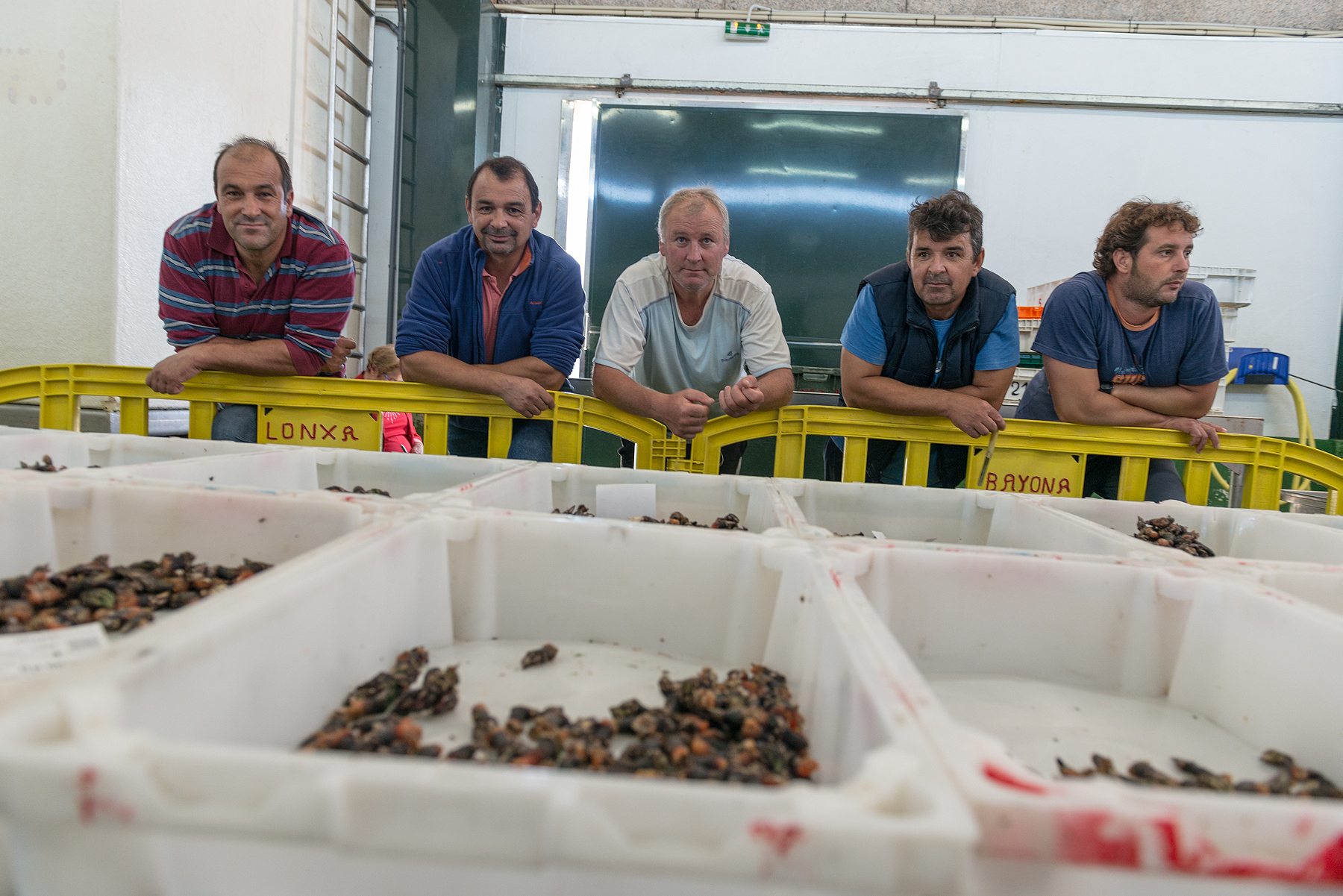
The percebes market is highly volatile, due to the fact that Spaniards eat barnacles at very specific times of the year. Summer attracts people to the coast and barnacles to the plate; the Christmas season brings about the most radical price surges, the market value tripling nearly overnight and provoking risky behavior from the region’s barnacle hunters. The surging economy of the 1990s and early 2000s helped change those habits, making it easier to shoulder the cost of barnacles year-round for consumers, but when the bottom fell out and la crisis set in, the value of percebes outside of Christmas and summertime plummeted.
Adding to the anxiety on the floor today is a general sense of concern surrounding the future of this industry. Five years ago, the quota in these parts was five kilograms per diver; today, it’s down to three. Nobody is happy about earning 40 percent less money for the same high-risk job, but like everything else in this great wet world, supplies are capricious, sporadic, dwindling. Academics and experts don’t know why barnacle supplies are disappearing. The best guess is global warming and the resulting rise in the ocean water’s salinity, which makes it difficult for delicate barnacle larvae to survive and thrive in rough conditions.
“I don’t know if percebe culture is sustainable. I really don’t,” says Susana. “But we’re trying our best to make it so.”
Those attempts are embraced by some who recognize in Susana and Isabel’s efforts a sober strategy geared toward the future. The opposition, fierce and persistent, comes from those who view reduced quotas and increased regulations as a direct threat to their immediate survival.
Gallegos are known throughout Spain for their special disposition—direct, emotional, capable of swinging from good-natured to punishing in a flash—and those traits spill out constantly onto the auction floor, the meeting hall, the ocean-battered rocks.
When I ask Isabel about the gallego character, she doesn’t hesitate: “Courageous and spontaneous and unpredictable. Like the sea.”
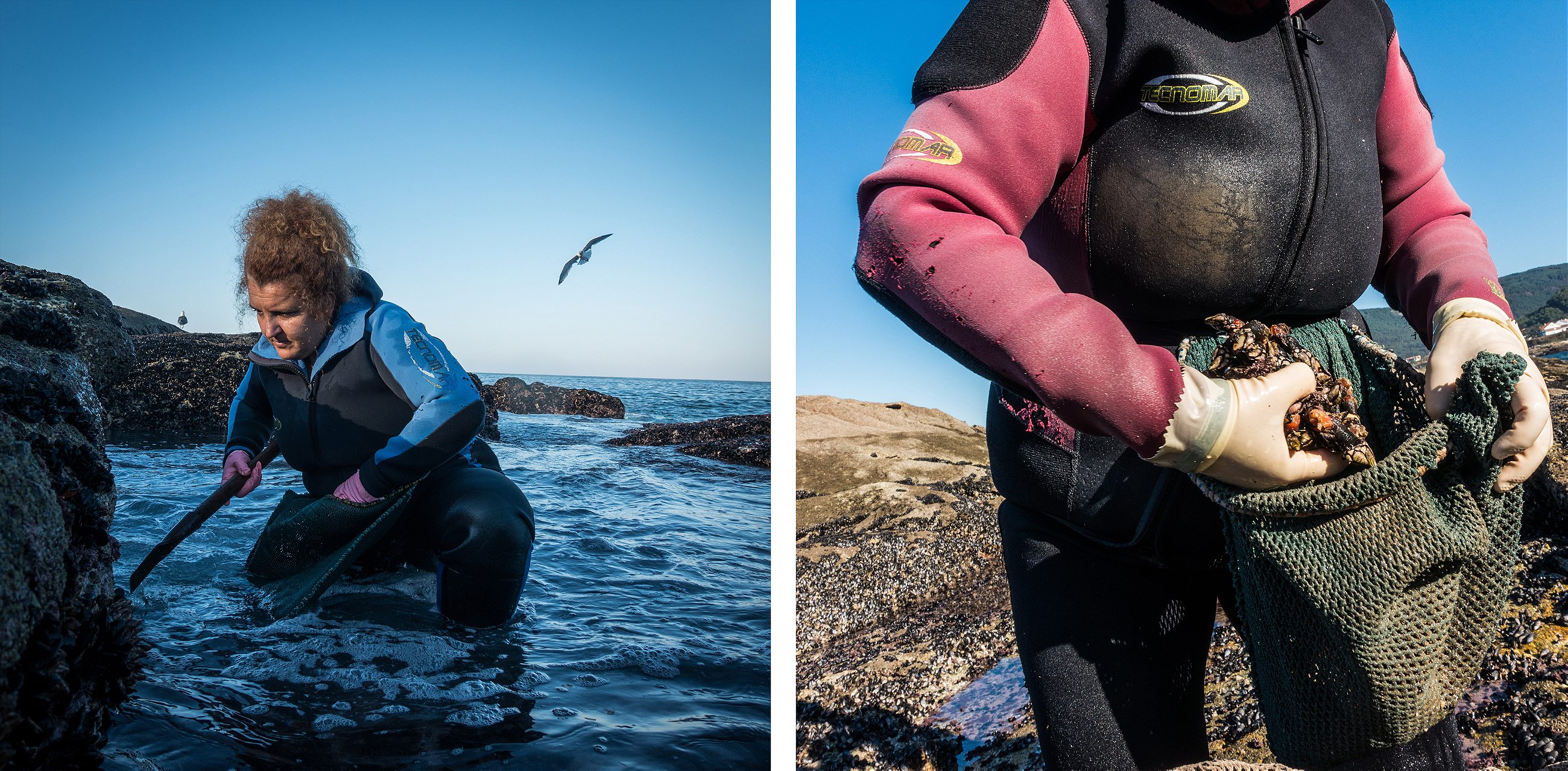
What do you do when the well dries up? What do you do when you’ve lived your entire life off the ocean, off octopus in the winter and rockfish in the summer and tiny juicy barnacles year round, then one day, when you’re out hunting down dinner along the same stretch of coast you’ve been working since your dad took you out and gave you a stick and a sack and taught you how to probe the dark underbellies of rocks until you felt the taught flesh of an octopus, how to scrape the mussel shells for worms for luring bottom-feeding fish, how the best barnacles are the ones that grow in the parts of the rocks where the elements—sun, rain, sea—are most extreme, and you’ve followed and refined that advice over the course of decades, during lean times and fat ones, until one morning, when you’re out looking for your next meal, someone in a uniform with a whistle in his pocket stops you and asks to see your license. License for what? You say. See that shack right there? That’s where I live. See that boy with the stick and the sack? That’s my blood. If you think I need a license to feed my family, you’ve got something coming to you.
Hunger will push a man to do dangerous things. Just ask Xosé Lorenzo. He has spent the past 12 years patrolling these shores. Part of his salary is paid by the government, but most of it comes from the percebeiros themselves, who pay him to keep eyes on both the licensed hunters and the ever-expanding mass of furtivos, poachers who work the rocks when they think no one is watching. Most of them aren’t fathers bringing home dinner for their families, but experienced hunters looking to cash in on the coastline without the cost of a license and the limitations of a quota or a schedule.
“You don’t want to know all of the threats they’ve made over the years. More than one hundred to me and my family and my children. Outrageous shit.” I ask him for a sampling. “Let’s see: ‘I’ll kill you.’ ‘I’ll cut your throat in your sleep.’ ‘I’ll burn your car.’ ‘I’ll shoot you in the leg.’ ‘I’ll go to your house and fuck your wife while you watch me.’ ‘I’ll kill your family first and make you watch and then I’ll kill you.’ ‘I’ll call a drug addict friend from Vigo who’s going to take a needle and inject you with AIDS.’ That last one was pretty interesting, I thought. I said, ‘Tell your friend where I live. You’ll see who ends up with the needle in his balls!’”
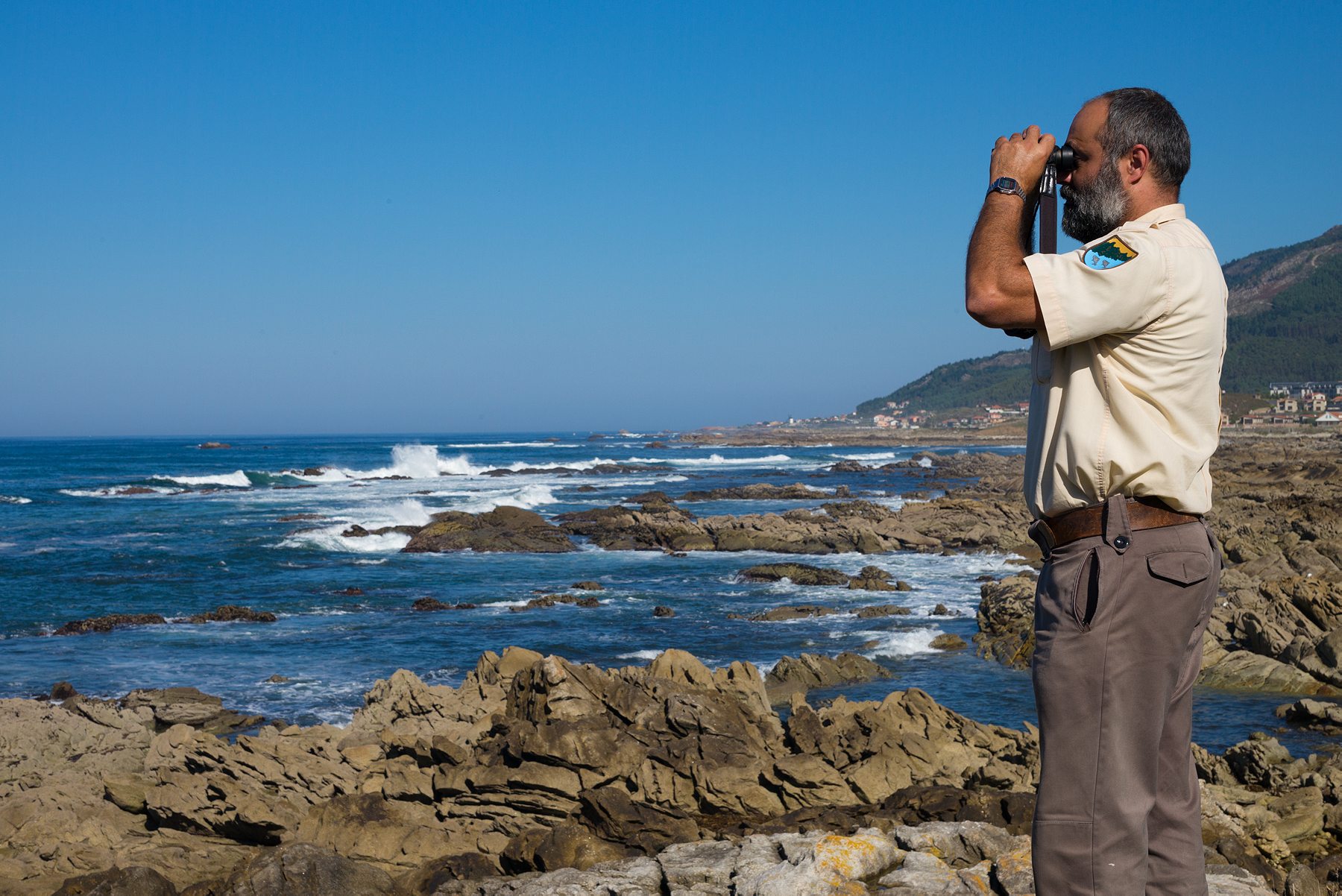
Xosé rattles these off with a mix of clinical precision and quizzical detachment, like a public defender running through a list of charges. But unfortunately, they’re not always empty threats. A year ago, he set out on his routine nighttime patrol route (“The poachers prefer to work under a blanket of stars,” he says) when he came upon the car of a well-known poacher. He pursued, following him down the coastline toward the Portuguese border. Suddenly, the car put on the breaks and two men in wet suits stepped out. “I thought they just wanted to talk. Then I saw the raspa.”
One slice to the head, another to the leg, and the poachers sped off, leaving Xosé bleeding on the side of the highway. He shows me the marks, pulls up pictures; later in the day, he sends me a video of him on the local news, undaunted by the vicious attack. “If they think that’s going to slow me down, they’re wrong.”
It’s one thing to come down to the sea to find something to eat for your family, Susana tells me. “It’s another to be selling percebes illegally to restaurants and jeopardizing our livelihood.” This is a small community, and everybody knows who the poachers are: Many are former licensed percebeiros who grew tired of paying fees; some are current members of the Bayona’s barnacle association who sell their quotas legally, shoulder-to-shoulder with their dues-paying colleagues, then sneak back out to collect barnacles to sell on the black market.
Despite the best efforts of guys like Xosé, one of six wardens hired by the Cofradía de Bayona to patrol the coastline, poaching has run rampant in recent years, thanks to a struggling national economy that has left more than a quarter of the country jobless. Unsurprisingly, a high percentage of the deaths and injuries in the percebes business come from poachers, who are forced to work in the most dangerous conditions to evade the wardens. The only tool of enforcement, beyond physical altercation, has been issuing fines, which go largely ignored by the bands of poachers. “I know a guy with a million euros worth of fines against him,” says Xosé. “You think that’s stopped him? There’s nothing to stop these guys from taking 1000 kilos of percebes whenever they feel like.”
That, everyone hopes, will change with the introduction of a new law this past summer, allowing the government to imprison poachers who don’t pay up. “Once we stick one or two of these assholes in jail, then we’ll see what the rest do.”
But anyone who slips out into the night with a wet suit and a headlamp to battle with the ocean and a labyrinth of serrated rocks isn’t thinking about tomorrow; he’s thinking about right now.

“How do you see it?” asks Isabel. “Do you think we can work the rock today?”
“Right now it looks good,” says Susana.
“But?”
“But I’m not sure we’ve seen what the sea can really do yet.”
“Yesterday was fine.”
“Yes, but today’s not yesterday.”
“True enough. So what do we do?”
“We wait. We watch.”
“For how long?”
“As long as we need to. Until we see one of those rogue waves crash and make sure there’s a place for us to hide on the rock.”
“I see a few good places. I know where we’ll be safe.”
“We all know the safe places. But until we see the big ones crash, we won’t know if they’re safe anymore.”
“You remember what happened to Belén. It was a day just like this.”
“Of course I remember. How could I forget?”
“That’s why it’s best to wait. I don’t trust this rock.”
“I don’t trust it either. The rock is a traitor.”
Today is not yesterday. Not even close. Yesterday, a bright, windless, warm autumn day, the González sisters worked this section of Zona 3 10 kilometers south of Bayona in relative calm. They had their choice of a stretch of rock untouched in months, allowing them to cherry-pick the biggest, fattest barnacles and leave behind the smaller ones that fetch lower prices in the afternoon auction.
They did surprisingly well on the selling block, fetching about 45 ($48) euros per kilo from a variety of buyers on a day when most of the barnacles went for 30. That’s 135 euros ($146) pretax in each sister’s pocket—not bad for a morning’s work. But when you do well in the auction, word gets out, and today, a group of 15 percebeiros are already combing the coastline by the time the sun comes up. Wrapped tight in black neoprene, poking and probing with long, pointed sticks, they look like a futuristic crew cleaning up the dregs of some violent environmental fallout.
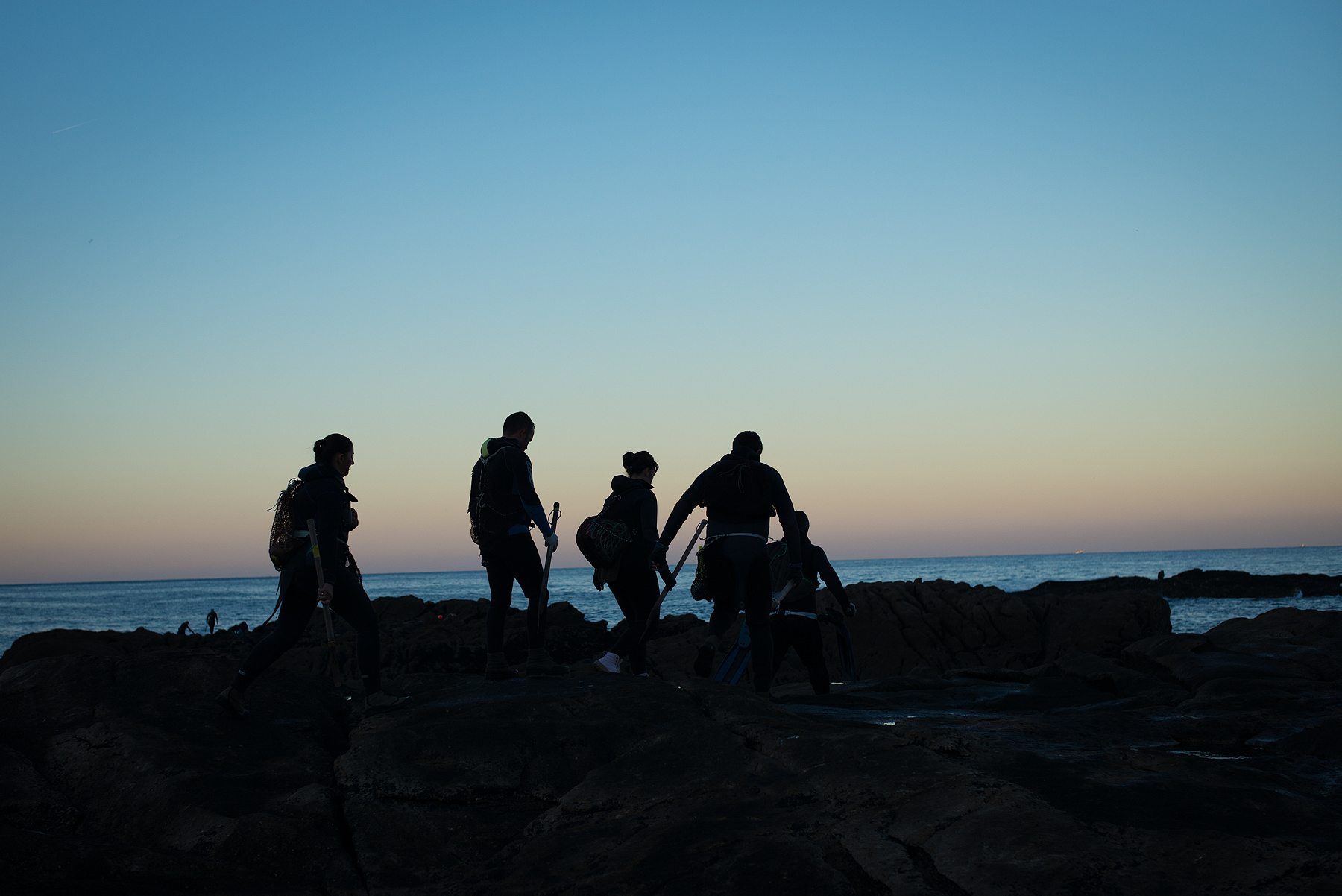
But it’s not the new company that has Susana and her sisters concerned; it’s the rising swells rolling in from the horizon. It’s clear and unseasonably warm, but the offshore winds have picked up, and with them, the waves that come slamming into the rocks where the best barnacles live. These are exactly the kinds of conditions you have to be most afraid of, says Isabel. Everything looks beautiful and easy, but beneath the surface, something bigger may be brewing.
They’ve brought a wet suit for me today—like their own, shot through with holes from years of use—and together we plunge into the water and cross the narrow ocean channel to the pointed rock island peaking just above the tide. Thirty meters long and 10 meters deep, it’s a small space for a dozen to share.
The workplace is a constantly morphing topography. As the tide shifts, so does the assortment of peaks and valleys, cracks and crevices you have to negotiate. It takes time to learn each venue, to understand how the currents pull, how the ocean vacuums, how one surface can diffuse the oncoming crush of seawater while another can amplify it. The good percebeiros know every rock on this coastline. Which ones will accept their feet under any circumstance, which ones will always do their best to pitch you into the Atlantic. For the percebeiros of Bayona, there are 47 distinct venues in their territory—places like Lover’s Point, with its narrow slashes of stone cutting through the water; Cow Shit, a chocolate-chip dusting of dark rocky points poking out of the white ocean froth; the Women’s Rock, large and flat and sturdy as a truck bed—and it takes years, if not an entire lifetime, to understand them all.
The best places for picking barnacles are also the most treacherous
Complicating matters, barnacles grow best where the elements—sun, rain, wind, sea—converge, which means the best places for picking are also the most treacherous: slippery surfaces; sheer rock faces; dark, hard shelves that are swallowed whole with each ocean swell. Two hours to the north, where the biggest barnacles grow, percebeiros hang from cliffs attached to ropes, scraping barnacles as waves smash them into the razor-edged rocks. The most important technique of percebeiros everywhere is the pick-and-run: to collect a handful of barnacles from the edges of the rocks as the tide ebbs, and escape before the next wave rolls in. “If you fall into the ocean and it spits you back out onto land, then you’re one of the lucky ones,” says Susana.
In the summer of 2014, Belén, the youngest González sister, was executing this exact maneuver when she hit a patch of seaweed and went tumbling down, falling head first onto a pointed rock that shattered her shoulder instantly. It was a perfectly normal day, sunny and blue and breezy like today, but one wrong step brought a changed life. She had a prosthetic shoulder put in place, and doctors told her she would never regain full control of her right arm. The Spanish government forced her into early retirement, and you can see in her face that sitting on the sidelines while her sisters continue the family business will be her life’s greatest challenge.
The sisters start slowly, working together in a tight formation in the relative safety of the center of the island. Eventually, they fan out, working their way toward the more perilous parts where the good stuff hides. Even then, they have an ingrained system of collective vigilance, one sister watching the sea swells as the other two work with their heads down. When she sees something forming that she doesn’t like, she’ll give an advanced warning. As a swell picks up steam, her verbal cues grow accordingly—from forecast to suggestion to pointed demand. “Isabel, get the hell out of there now!”

The gear itself proves a persistent dilemma—finding the happy middle between something that keeps you warm and protected without restricting your movement. Susana, for example, wears a three-millimeter wet suit, even in the dead of winter when the water temperatures are near freezing, to allow for maximum mobility. And only in the most extreme conditions will the sisters put on the hoods of their wet suits, since covering your ears means eliminating one of your most valuable warning systems.
The raspa is the one absolutely indispensible tool of the percebeiro, a thick wooden stick with an iron knife at the end that allows the hunters to scrape the barnacles cleanly from the rocks. The raspa gets so much use that the sisters take theirs to a local sharpener for a tune-up every five days.
The thick groupings of percebes may look the most appealing, tucked in tight and resembling a wall of prehistoric toenails, but those go mostly untouched by the sisters. When I excitedly point out to Isabel what I think is the discovery of a cache of juicy barnacles, she quickly curbs my enthusiasm. “Those won’t work. You can’t pull them off with the base intact, so as soon as you pick them, they begin to lose water and wrinkle. Good percebes last for a week; within a day, these’ll be dead.”
Isabel explains that the best barnacles are short and stout, not necessarily the longest or the loveliest, but with a solid base and a generous circumference. The flavor from one barnacle to the next doesn’t change dramatically, she says, what people pay for is texture. At its best, this edible appendage should snap like an ocean hot dog, releasing a flood of warm umami to the enraptured eater.
An hour into the excavation, the swells start picking up. A wave knocks one of the men onto his back before two partners pull him out of the tide. Another sweeps a man off his feet as he’s trying to jump from one rock to another. I can feel my heart suddenly beating in my throat, as the imagined danger of a barnacle hunter suddenly becomes very real.
We’re in the danger zone
Susana looks at her watch: 10:46 a.m. Low tide today is 11:19, meaning we’re in the danger zone, the 30 minutes before the ocean bottoms out, when the swells are most savage. Suddenly I look around and see that we’re alone, the sisters and me, on what’s left of the vanishing island.
They talk rapidly among themselves, shifting their eyes from the horizon to the coast behind us, where the others have fled for higher ground. The gallego they speak, with its Portuguese cadence, the pinched-cheek pronunciation that turns the hard edges of Spanish syllables into soft, rounded corners, belies the severity of the situation at hand.
Finally, Susana sees me and switches back to Spanish. “We need to get off this rock. Now.” Try as we might, we cannot tame the ocean. Over thousands of years of evolution, we’ve learned to subdue nearly every other part of nature: leveling forests, damming rivers, dynamiting mountains down to molehills. Converting patches of inhospitable desert sands into spectacular oases of sin. But no amount of determination or technology or accumulated understanding can weaken the ocean’s resolve.
It’s not for lack of trying. Trapped in its tides is the answer to our most pressing questions, an inexhaustible supply of energy this planet will need to survive. We flirt constantly with its potential; there’s a reason why the world’s most dangerous jobs—from king crab fishing to underwater welding to barnacle hunting—take place in or on the ocean. In Spain, in Galicia above all, people refer to the ocean in two ways: el mar or la mar. Masculine and feminine. One gives us life, the other takes it away. It’s up to you to decide which is which.

The danger of the barnacle hunter is the knowledge that even the slightest edge—a learned intuition, a measured bravery, an extra bit of resistance in the legs—means a better life for you and yours. For them, the ocean is both an open invitation and a standing threat. Ask Susana about the most important skill in a percebeiro’s tool kit and she won’t hesitate: respect. Deny the ocean the respect it demands and it will drag it out of you, one way or another.
Just ask the plump octopus fisherman trembling on the rocks. As we vacate our vanishing island, swim back across the water in between swells, drag ourselves onto higher, dryer ground, he stands stubbornly on the edge of the rocks, his long bamboo stick probing beneath the water. One of the women warns him about the waves, but he tells her to leave him alone.
Twenty minutes later, after the González sisters drag his trembling body from the ocean and leave him in the hands of his panicked wife and a group of paramedics, they are back on the rocks, scraping up a living.
Only when they hit their quota do they relax. Isabel grabs a sea urchin, cracks it open, scoops out its soft orange innards and eats it with her fingers, seasoned with nothing but seawater. She passes one to Susana, another to me.
“People ask me if I ever think of finding a different profession,” says Isabel, picking through her bag of barnacles, doing rough calculations of what she might expect to fetch at today’s auction. “Are you kidding me? You think I want to work at a desk? This is my office: the ocean, the coastline. I’m out in the open air, the wind in my face, my sisters by my side. What could be better than this?”
